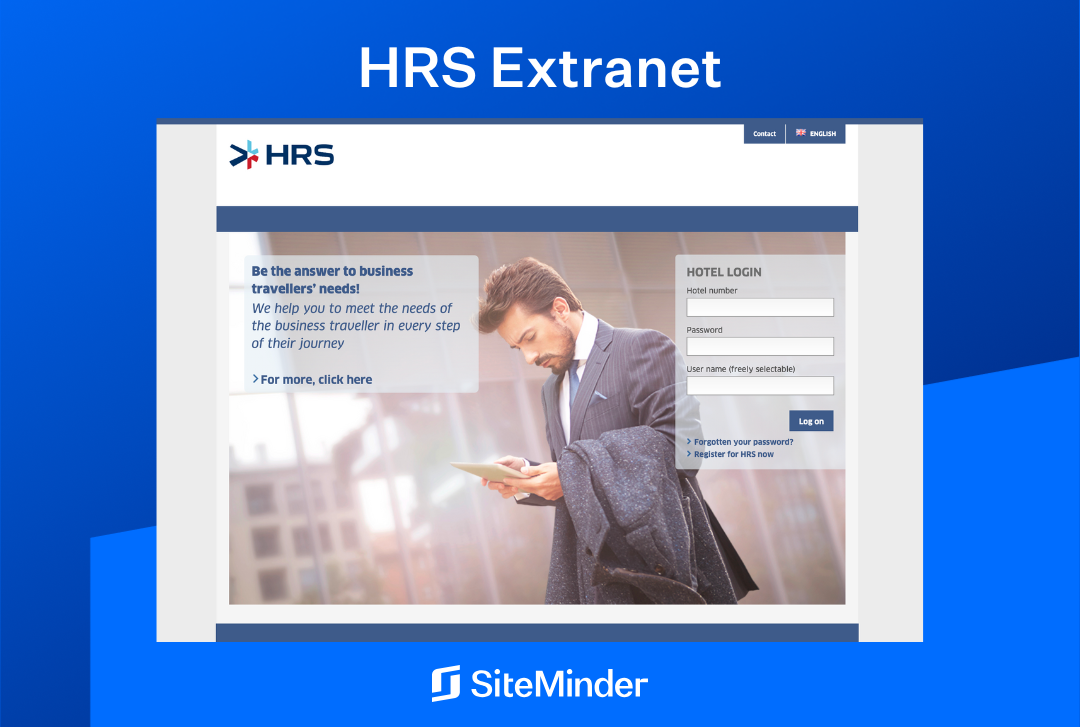What is the HRS extranet?
The HRS extranet allows hotels to manage bookings, rates and availability within HRS, a booking platform that offers access to 3000+ corporate travel programs.
The HRS extranet, aka HRS HotelPortal or Hotel Service Portal, is used to control a hotel’s presence on HRS. When fully integrated into a hotel’s tech stack, the HRS extranet can be accessed and controlled through a PMS or channel manager.
What does HRS stand for in hotels?
What is HRS in hospitality? It stands for Hotel Reservation Service, the accurate name of a hotel booking platform that focuses on corporate travel programs.
In this blog we’ll zoom in on the HRS extranet hotel platform, to understand what it is, how it works, and how a HRS hotel partner can get maximum value from it.
Table of contents
The importance of HRS in hospitality
What is HRS used for? In short, HRS has carved out a niche in the corporate travel sphere, specifically by granting its hotel partners access to thousands of corporate travel programs run by some of the world’s largest brands.
HRS also provides hotel partners with tools for marketing and payment processing. In return for this access and assistance, HRS charges a commission on every corporate booking it facilitates.
What are the benefits of HRS for hotel chains?
What is the purpose of HRS? To grant hotels access to the valuable corporate travel program market. Why might a hotel want to gain access to this market? A few reasons:
- Corporate travel is growing: Recent statistics show corporate travel has a year-on-year growth rate of 8-12%, and the value of this travel sector will reach USD $829.5 billion within the next five years.
- Business travellers fill gaps: Corporates tend to book on weekdays and through low seasons, helping a hotel to maximise occupancy.
- Travel programs provide regular business: The contractual nature of travel program partnerships means long-term relationships can be developed, which results in stays being booked more frequently, businesses being less price sensitive.
HRS can prove incredibly useful to any hotel business targeting the corporate travel set, so let’s look at how the HRS extranet can most effectively be used.
Unleash the power of HRS with SiteMinder
Offering complete HRS integration, SiteMinder lets you control HRS through the same screen that you control every other booking channel. Stop jumping from extranet to extranet, and fully capitalise on the opportunity presented by corporate travel.
Learn more
Core functions of the HRS extranet
HRS extranet login in hand, you’re ready to make the most of the platform. But exactly what functionality does it offer? Five core functions include:
Centralised multi-property management
The HRS extranet allows your hotel group to manage multiple properties from the one place. This streamlines operations, maintains uniformity across locations, and offers consistent control over room rates, availability and booking policies.
Mobile check-in and check-out
HRS supports mobile check-in and check-out, allowing time-poor corporate travellers to bypass traditional front desk processes, improving the guest experience while reducing the workload for front desk staff.
Two-way data synchronisation
Two-way data synchronisation ensures that room rates, availability and bookings are updated in real time across all connected systems. When HRS integrates with a system like SiteMinder, every single booking channel can be automatically updated as soon as a new booking is made.

Security and data privacy
The HRS extranet places a strong emphasis on security and data privacy. It implements robust encryption and compliance measures to safeguard both hotel and guest information. This builds trust with corporate clients while guarding your hotel against cybersecurity issues.
Automated workflow efficiency
Automated workflow tools in the HRS login extranet reduce manual processes and allow your staff to shift their focus from completing menial administrative tasks to delivering high-end corporate traveller service, while getting admin completed quicker and more accurately than ever before. You can automate reservation updates, guest data and reporting, and you can expand these automations well beyond the HRS extranet by connecting the tool to a platform like SiteMinder.
Best practises to maximise the HRS extranet
The HRS hotel extranet is brimming with potential – it’s up to you to realise it. That’s no simple task, as the platform forces you to compete directly with a wealth of other hotels targeting the exact same customers. But by using the extranet wisely, you can increase your chances of both winning and retaining valuable corporate travel business.
Analyse data and segment corporate travel markets
The HRS extranet provides a wealth of data that you can use to identify patterns in corporate travel behaviour, which can then inform your ongoing corporate travel strategy. Segment by industry, company size or booking frequency, then tailor offers to meet the needs of certain groups.
Forecast demand from corporate travel segments
Use historical data to anticipate corporate travel demand. Forecast the busy periods for business travel to better manage inventory, adjust staffing and prepare tailored promotions that will ensure you secure corporate bookings.
Implement strategic pricing for corporate bookings
By integrating HRS with SiteMinder, you can capitalise on SiteMinder’s hotel business intelligence tool, which powers dynamic, real-time pricing strategies. Consider offering your corporate clients exclusive rates, volume discounts and flexible booking options.
Increase visibility on corporate booking platforms
By regularly updating and optimising your HRS profile through the extranet, you can ensure your hotel stands out to potential corporate customers. Highlight corporate-friendly services and amenities and participate in HRS promotional campaigns.
The best way to increase your visibility to corporate travellers? Establish a presence not just on HRS, but on every platform they use. By offering deep integration with HRS and a wealth of other corporate travel platforms, SiteMinder helps you do exactly that.

